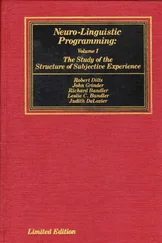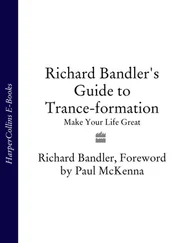Barb: Yes.
So the laugh would never have emerged if I had gone on with the induction. Her response was so immediate and distinct that I wanted to make sure all of you noticed. Woman: What happened to me when you did the induction is kind of strange. I was trying to watch you, because that was my job, and instead I went through the whole thing myself. I was really embarrassed because my hand was coming up and—
Well, you had lots of company. About thirty other people sitting out Where did, too, so don't be too embarrassed.
Larry: Can you give us more words that you use for internal responses—things you were guessing she was feeling inside?
Well, I wasn't guessing. I was leading at that point, I was asking her to create those experiences. I didn't use the words "security" and "comfort" based on what I was seeing, because 1 don't know if the signs that she was offering me mean security and comfort for her. I just know those are general words that are often associated with muscle relaxation.
Larry: Right. I am trying to find out other words you would use for 'that,
There are lots. You can use words like ease, peace, serenity, calmness, or being centered. They are all just words. They don't have any intrinsic meaning. They are interpreted individually by each person for his or her own needs.
I'm insisting on making a clear distinction between sensory–grounded descriptions and non–sensory–grounded descriptions. The sensory–grounded descriptions allow me to get into synchrony with her. The non–sensory–grounded descriptions allow me to offer her very general procedures that she can use idiosyncratically. Her interpretation of these will be rich and meaningful and individual to her. I have no idea what they are, but that's fine. That's content, and that belongs to her. My job is to run the process.
This is a very simple word induction, and you can always fall back on it. It will work. It just takes longer than some of the other fancier ones. When you use it, remember to connect the statements about sensory–grounded experience to the statements about internally–oriented states. This is called "causal modeling." The simplest and weakest way to connect statements is to use the word "and." "You hear the sound of my voice and you feel the warmth where your hands are resting on your thighs and a growing sense of comfort and, …"In the induction I did with Barb, I started linking with the word "and," and then I moved to a stronger form of linkage. "The feeling of warmth and support as your body fits against the chair will allow you to grow even more comfortable."
There are three kinds of linkage. The simplest is "X and Y." The next stronger form is "As X, Y" "As you listen to the sound of my voice, you will become more comfortable," or" When I reach over and touch you on the knee, you will have a sense of dropping into an even more relaxed state." " While you are sitting there listening to the sound of my voice, your unconscious mind can prepare a particularly interesting recall of a pleasant childhood experience." The strongest form "X causes Y" uses words like "cause" or "make" "The lifting of your arm will make you drift off into a pleasant memory."
So the pattern is to say four things that are immediately verifiable, and then connect them with an "and" to an internally–oriented state that you are proposing. First you have the pacing and then the leading. As you proceed, you can gradually increase the number of internally–oriented statements, and you can gradually go from a weaker form of linkage to a stronger form.
Linkage can be very powerful. It's astounding how much linkage goes right by people's conscious minds, and yet has an impact. Once I literally had somebody go totally blind in a seminar. I was demonstrating something, and I said "All you need to be able to do is see in order to do this" I had linked seeing to being able to do the task. After I went through the demonstration, a woman raised her hand and said "I have a question." I asked her what the question was, and she answered "What do you do if you can't see anything?" I thought she meant she hadn't noticed the person change in my demonstration, so I said "You weren't able to sec any responses?" She said "No, it's totally dark."
She wasn't worried at all, but I was thinking "Hey, wait a minute here!" I went over to her and said "You don't have to learn this" and poof … her vision came back.
That woman's response was very unusual. For most people, the linkage will work the other way. Since they can see, they will be able to do the task. As long as you know what you're linking to what, you'll be able to deal with whatever impact it does have.
Nonverbal Pacing and Leading
All hypnosis can be usefully thought of as feedback. At this moment Bob is sitting in front of me. We are passing lots of information back and forth both verbally and nonverbally. Out of all the messages that we offer each other, some are conscious—that is, he and I know that we are offering them—and some are not.
One thing I can do with Bob's messages is to select those which I can identify as being outside of his awareness, and begin to feed those back by body mirroring. As 1 feed those back, one of two things will happen. His consciousness will alter and he will become aware of those things, or his unconscious responses will simply be amplified, so that more and more of his responses will be unconscious and fewer and fewer of them conscious.
After you have paced some unconscious response, you can begin to amplify or lead into some other response. I can pick out any portion of Bob's nonverbal behavior and do this. I can pace his pupil dilation by dilating my own pupils, and then, as I look at him, begin to defocus my eyes only as fast as he will follow me. Defocused eyes are a good indication of trance, because they accompany internal processing as opposed to focusing on something in the external world.
1 can match his eyeblinks and then gradually blink my eyes more often and more slowly until I get him to shut his eyes. I can mirror his muscle tonus and then slowly relax my own muscles to assist him in relaxation. When you pace and lead nonverbally, there's no need for talk. You just mirror to get rapport, and then slowly put yourself into an altered state of consciousness, making sure that the other person is following you.
Pacing and leading is a meta–pattern. It's actually a part of every other induction we'll be teaching you. You can use nonverbal pacing and leading either by itself, or as a part of another induction. I recommend that at some point you practice just the nonverbal portion. Without words, just arrange yourself in a mirroring position. Then you can very slowly—noticing how fast the person follows you—put your self into a deep trance. Be sure to have some way for you to come back out.
Overlapping Representational Systems
For those of you who don't know what representational systems are, let me explain briefly. We noticed some time ago that people specialize in the kind of information they process and pay attention to. If you divide experience into information in the different sensory channels, you have a visual chunk of experience, an auditory chunk, and a kinesthetic chunk. You also have olfactory (smell) and gustatory (taste) chunks, but those two channels don't generally take up very large portions of your experience unless you arc cooking or eating. In our normal state, some of us are primarily aware of visual experience, some primarily auditory, and some primarily kinesthetic. We call these representational systems, because they are the systems that we use to represent our experience. The words we use when we talk about our experience are an indication of which sensory channel we are consciously using.
Читать дальше











